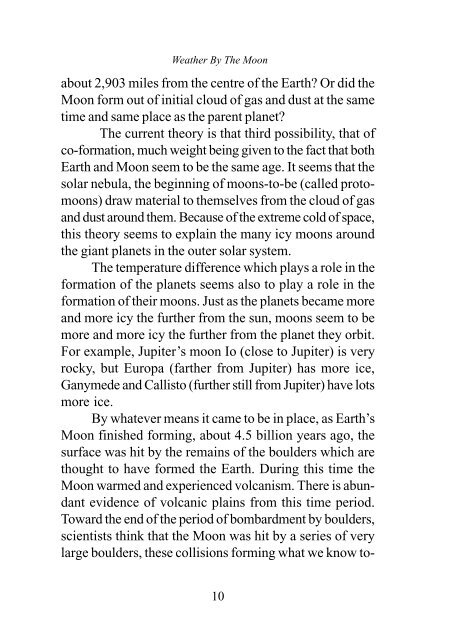- Page 1 and 2: FREE PDF BOOK The Original PREDICTI
- Page 3 and 4: Despite requests to desist, this pr
- Page 5 and 6: Contents THE FORMATION OF THE MOON
- Page 7 and 8: LOOKING DIRECTLY AT THE MOON ......
- Page 9: Formation of the Moon OTHELLO: ‘I
- Page 13 and 14: Formation of the Moon no water. Moo
- Page 15 and 16: Formation of the Moon tennis ball.
- Page 17 and 18: Formation of the Moon so, then the
- Page 19 and 20: The Moon in Ancient History Mesopot
- Page 21 and 22: The Moon in Ancient History Indo-Eu
- Page 23 and 24: The Moon in Ancient History could i
- Page 25 and 26: The Moon in Ancient History the 28
- Page 27 and 28: The Moon in Ancient History is usua
- Page 29 and 30: The Moon in Ancient History To the
- Page 31 and 32: The Moon in Ancient History land to
- Page 33 and 34: The Moon in Ancient History Charles
- Page 35 and 36: The Moon in Ancient History strual
- Page 37 and 38: Early Moon Watchers lore was Aristo
- Page 39 and 40: Early Moon Watchers And as Bartolom
- Page 41 and 42: Early Moon Watchers inhabitants of
- Page 43 and 44: Early Moon Watchers Diana...Diana..
- Page 45 and 46: Planting by the Moon Moon, her char
- Page 47 and 48: 1 Whiro 2 Tirea 3 Hoata 4 Oue 5 Oko
- Page 49 and 50: Maori and the Moon Seven Sisters. T
- Page 51 and 52: MADNESS, ILL-WINDS, AND THE MOON On
- Page 53 and 54: Madness and the Moon it is conceiva
- Page 55 and 56: Madness and the Moon erly wind in s
- Page 57 and 58: Madness and the Moon 6.00pm news. R
- Page 59 and 60: Madness and the Moon is as predicta
- Page 61 and 62:
ible and where to look. This applie
- Page 63 and 64:
NEW MOON The New Moon cannot be see
- Page 65 and 66:
its visible disk is lighted, called
- Page 67 and 68:
are more likely to be clearer from
- Page 69 and 70:
Tides and What pulls What The weath
- Page 71 and 72:
Tides is always a corresponding hig
- Page 73 and 74:
Tides ies exert pulls on earthly th
- Page 75 and 76:
Tides night. As high tides are prod
- Page 77 and 78:
Tides rotation. As Earth’s rotati
- Page 79 and 80:
The atmosphere shelters us from the
- Page 81 and 82:
Tides manifestations such as aurora
- Page 83 and 84:
Tides Air has mass. A submarine has
- Page 85 and 86:
Tides radio reception. Before satel
- Page 87 and 88:
Tides sharply as the ground radiate
- Page 89 and 90:
Tides the Moon’s phase allows the
- Page 91 and 92:
Earthquakes ment north and south of
- Page 93 and 94:
PERIGEES AND APOGEES The rising or
- Page 95 and 96:
Perigees and Apogees to New or Full
- Page 97 and 98:
Perigees and Apogees a switch and m
- Page 99 and 100:
Perigees and Apogees its. Apogee an
- Page 101 and 102:
Perigees and Apogees the Apogee. Go
- Page 103 and 104:
Perigees and Apogees PERIGEE AND DI
- Page 105 and 106:
Perigees and Apogees out in 400 yea
- Page 107 and 108:
Comparing Cycles YEAR1996 Perigee A
- Page 109 and 110:
The Moon’s Declination Many folk
- Page 111 and 112:
on the table surface. If you could
- Page 113 and 114:
Declination days, while weather occ
- Page 115 and 116:
Declination But if the Moon is not
- Page 117 and 118:
Declination the Sun, the Earth, and
- Page 119 and 120:
Declination month out, year in and
- Page 121 and 122:
The range of influence of the Moon
- Page 123 and 124:
Declination mum Declinations are ab
- Page 125 and 126:
Declination left bank line is the M
- Page 127 and 128:
What Causes Weather? The Moon gives
- Page 129 and 130:
What Causes Weather of Earth to the
- Page 131 and 132:
alleling them. What Causes Weather
- Page 133 and 134:
What Causes Weather ple died. All t
- Page 135 and 136:
What Causes Weather tern in May 200
- Page 137 and 138:
What Causes Weather SCIENTISTS SOME
- Page 139 and 140:
What Causes Weather travel more to
- Page 141 and 142:
What Causes Weather ing. The differ
- Page 143 and 144:
The Barometer In 1638 Galileo notic
- Page 145 and 146:
NEW MOON RISING SETTING ATMOSPHERE
- Page 147 and 148:
Barometer Pascal also missed a prev
- Page 149 and 150:
Barometer rain could ensue again. I
- Page 151 and 152:
Predicting 1. PLOT DECLINATIONS FOR
- Page 153 and 154:
Predicting JANFEB MAR APR MAY JUN J
- Page 155 and 156:
Predicting OTHER FORECASTING SYSTEM
- Page 157 and 158:
Predicting HISTORICAL EVIDENCE FOR
- Page 159 and 160:
and cirrus means a storm coming. Wh
- Page 161 and 162:
Predicting for 40 days ‘twill rai
- Page 163 and 164:
Predicting Ants hurry to and fro ca
- Page 165 and 166:
165 northwest. WEATHER IN USA(GENER
- Page 167 and 168:
Looking Directly at the Moon Watch
- Page 169 and 170:
Predicting At this phase, the Moon
- Page 171 and 172:
Predicting until Last Quarter, beca
- Page 173 and 174:
Predicting Hemisphere or southwest
- Page 175 and 176:
Weather Maps (also called the geopo
- Page 177 and 178:
Weather Maps respectively the Ameri
- Page 179 and 180:
Weather Maps The captain of the int
- Page 181 and 182:
Weather Maps 181
- Page 183 and 184:
Weather Maps Moon to Earth for the
- Page 185 and 186:
Weather Maps lination points. On th
- Page 187 and 188:
OTHER WEATHER CONDITIONS NAME DEW F
- Page 189 and 190:
QUICK ATMOSPHERIC-TIDE CHART (SOUTH
- Page 191 and 192:
etween water and air when they are
- Page 193 and 194:
Questions percentage of air shifted
- Page 195 and 196:
Appendix 1 TRADITIONAL NAMES FOR FU
- Page 197 and 198:
no cell-phones, and one had to cont
- Page 199 and 200:
Journey Once we learned what they w
- Page 201 and 202:
Journey (11) - non-stop wind and ra
- Page 203 and 204:
Journey interested, not even in see
- Page 205 and 206:
Journey for two years. As an umbrel
- Page 207 and 208:
ACKNOWLEDGEMENTS Foremostly I owe m
- Page 209 and 210:
1965 Brier, G.W., Diurnal and semid
- Page 211 and 212:
1965 Levengood, W.C., Factors influ
- Page 213 and 214:
sachusetts, Chapters 6 and 7, 1973
- Page 215 and 216:
Janthron Press How The Moon Affects
- Page 217 and 218:
Apogee/Perigee cycle 93 Apogees 93
- Page 219 and 220:
cloud 158 Cloudiness 63 clumsiness
- Page 221 and 222:
G gale 149 Gales 175 Galileo 41, 14
- Page 223 and 224:
Japan 27 Johannes Kepler 40 John Qu
- Page 225 and 226:
Moon Festival 30 Moon Festival. 29
- Page 227 and 228:
priests 38 Proverbs 160 Ptolemy 39
- Page 229 and 230:
Thunder Moon 195 thunderstorm 51, 7





